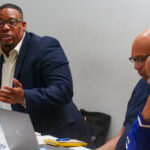By: William W. Green
Kindred hosted a Capital Readiness Collaborative Session; a gathering focused on identifying the challenges Black-owned small businesses face in accessing capital. The room was filled with decision-makers from Business Support Organizations (BSOs) and Community Development Financial Institutions (CDFIs)—two groups with different perspectives but one shared mission: closing the funding gap that has long hindered growth and sustainability for Black entrepreneurs.
BSOs are rooted in their communities, helping business owners build the skills and knowledge to grow. At the same time, CDFIs provide the capital that fuels that growth. But too often, a gap between the two leaves entrepreneurs just shy of the funding they need to truly thrive. One participant described this gap perfectly, stating, “It’s not always the credit score; sometimes it’s about understanding the numbers and knowing how to manage capital effectively.”
This disconnect is evident in the data. According to the Federal Reserve, nearly half of all small businesses in the United States do not receive all or part of the financing they seek—despite the abundance of capital in the ecosystem. The issue isn’t necessarily the availability of funds, but rather their accessibility and effective deployment to those who need them most.
The disparities are even more glaring for Black small business owners. They are more likely to apply for loans or lines of credit than the national average (44% vs. 35%), yet less likely to receive the full amount requested. Only 32% of Black applicants receive the total funding they seek, compared to 40% nationally. This points to systemic barriers that continue to limit equitable access to capital and opportunity.
The session sparked open discussions, problem-solving, and strategic brainstorming, which led to a compilation of innovative solutions like automated financial assessments and tiered capital readiness programs. These ideas can transform the pathway from business readiness to secured funding.
Key Takeaways: Building Stronger Pathways to Capital
1. Long-Term Support for Entrepreneurs
Entrepreneurship is a journey, not a sprint. Support must extend beyond the startup phase, providing financial guidance, technical assistance, and strategic coaching to help businesses navigate growth and sustainability.
2. Transparency and Alignment in Lending Criteria
Misalignment between BSOs and CDFIs—like varying Debt Service Coverage Ratios (DSCR)—often leads to entrepreneurs seeking funding they aren’t prepared for. Better calibration and open communication can streamline the journey to capital. As one attendee noted, “When BSOs understand the criteria, it’s like giving entrepreneurs the right map to find the funding they deserve.”
3. Lending vs. Investment: Understanding the Difference
Not all businesses are ready for traditional loans. Sometimes, venture capital or mixed financing is a better option. BSOs play a critical role in educating entrepreneurs about these options. “Sometimes it’s not about getting a loan; it’s about finding the right kind of capital for where your business is today,” shared one CDFI representative.
4. The Real Issue: Financial Readiness, Not Capital Shortages
The real challenge isn’t only the lack of money, it’s financial readiness as well. Many businesses struggle with a strong infrastructure and building the systems needed to access capital. Entrepreneurs often blur the lines between business revenue and personal income, leading to cycles of feast and famine. Stronger financial education and support can instill sound money management habits.
5. Embracing Risk While Building Resilience
Taking risks fuels growth, but poor financial habits can turn that risk into a liability. Rather than avoiding risk the focus should be on building resilience through strategic financial planning.
The way forward is clear: alignment, education, and strong support will open new doors and drive lasting growth for those often left out. To truly empower Black-owned businesses, we must close the capital gap—not just in access, but in readiness. The foundation is set; now it’s time for bold action.








